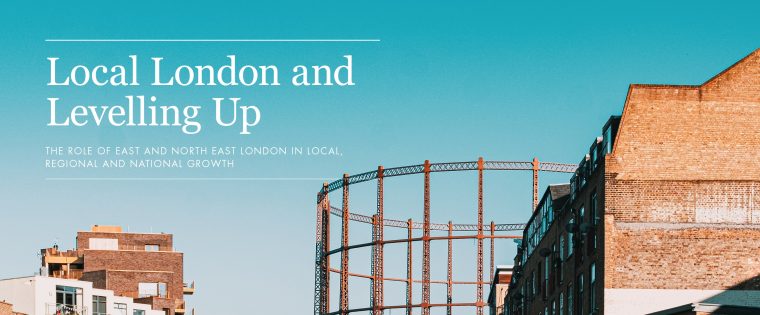Local London and Levelling Up
The role of East and North East London in local, regional and national growth
Author: Joe Fyans |

The relationship between the levelling up agenda and London has been the subject of intense scrutiny, both inside and outside of the city. The Local London subregion – comprising the boroughs in East and North East London – presents a clear problematisation of the often-presented view of London as a universally prosperous economic monolith. Local London and Levelling Up presents a positive case for investment in East and North East London, to the benefit of growth local, national and regional.
Download the executive summary.
Key points
East and North East London have a lot to offer the levelling up agenda
As well as sharing many of the challenges felt by areas often described as ‘left behind’ and seen as the key targets for levelling up, the area also shares many of the UK Government’s priorities encompassed in the levelling up agenda and broader push to build back better, with tangible opportunities within the subregion to advance these goals. Growth opportunities in Local London centre on altering the industrial mix in the area to raise productivity closer to the London regional level, using improvements in connectivity both physical and digital to create a network of town centres acting as employment hubs for the knowledge-intensive service sector. Investment opportunities in Local London include prospects for regeneration and development on brownfield sites and associated infrastructure improvements, as well as a need to double down on existing infrastructure projects in the Thames Estuary and the London-Cambridge corridor.
The goals of the levelling up agenda are felt and needed in East and North East London
When compared with other London subregions and the mayoral combined authorities, the economic need for levelling up in the subregion is pronounced. Need for a levelling up in the quality of life of many residents in the subregions left behind communities is evident across numerous metrics, including health outcomes and material standard of living. Economic divides within London, and more broadly between city subregions, are reflected in the labour market. Local London lags the rest of London on metrics of skills, employment quality and productivity – with the trend pointing towards a widening gap. The risk of being further ‘left behind’ is therefore acute in the Local London subregion. This situation is not static, government policies around the economy can either address and alleviate this condition or ignore and exacerbate it, with the associated damage to national growth and prosperity.
Recommendations
A masterplan deal for Local London
Good planning is essentially to sustainable and good quality growth in thev Local London area. Coherent strategy at the sub-regional level can help achieve levelling up for residents in left-behind areas of Local London, whilst also benefitting the national agenda by providing the receipts of boosted growth to the Treasury.
London’s geography is moving Eastwards – with multiple major developments with varying levels of national significance detailed in this report – and it is important that growth is managed, inclusive of residents and maximises national benefits. To ensure that the provision of skills, employment and housing are co-ordinated and serve the overarching national, regional and local goals for recovery and renewal, as well as being connected with the bordering areas to London and associated projects, a formalised subregional convening role is required.
Local London needs a subregional deal for growth, giving the subregional leadership board power to convene and coordinate constituent boroughs and external partners in delivering levelling up. A multi-year ‘masterplan’, encompassing the different borough’s local and corporate plans into an overall vision for the area must be agreed and funded between the boroughs, the government and the Greater London Authority.
Key features
- The master plan would tie in and be developed in consultation with key stakeholders of the Innovation Corridor and the Thames Estuary Growth Board to give a full impression of the growth trajectory across the area.
- Producing a long-term vision for the subregion would provide stability conducive to business investment and give an impression of the aggregate skills demand of the future labour market, allowing for local london 7 and levelling up better collaboration between Local London and local further and higher educational institutions.
- To ensure proper local buy-in and to capture the benefits of local expertise, community consultation must be a golden thread throughout the document – from ensuring and promoting the use of both digital and physical consultation on individual local plans, through to maintaining a clear and transparent working process in devising the overall master plan.
- Targets for the master plans outcomes in residents’ lives must be agreed between all tiers of governance at the outset, with clear and definable metrics identified for levelling up quality of life, employment and environment in left behind communities.
Funding requirements
The key requirement for a master plan would be funding for the process of devising and carrying out the plan, along with ‘buy-in’ support from both a central government and GLA level. The subregional leadership must have the funding to recruit qualified and capable staff, and must also have the certainty that this funding will not be withdrawn at the change of a political cycle. Agreeing the aims and scope of a master plan deal could be carried out in broadly the same manner as devolution deals are reached between government and devolved areas, where funding is provided for the administration of the master planning process based on key shared outcomes.
Project kindly supported by

